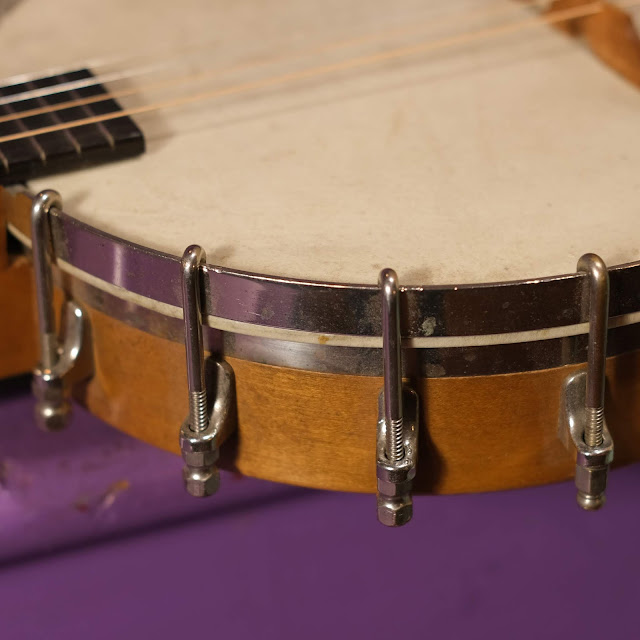1924 Weymann Style 35 4-String Banjo-Mandolin Conversion
It's become my opinion that 4-string banjo-mandolins are far more fun than 8-string versions. I've been converting most of these "thwackers" (as my buddy Todd calls them) into 4-strings lately and so I did the same to this nice little 9" rim Weymann after I received it in trade. The result? Yeah, of course it sounds great! It's like having a tenor banjo but tuned up to where mandolin players find them useful. Who wants to transpose all the time for CGDA tuning? Also: four strings don't go out of tune as much as 8 on a banjo rim and it's easier to get them in tune in the first place.
Rambling aside, Style 35 Weymanns are solidly-built instruments and high-quality, too. This one came to me all-original save its bridge and the ebony shims used in the neck brace. While the 9" head means adding a synthetic head incurs the wrath of waiting months for Remo to make you an $80 custom-sized one, this original skin one is in good shape and holds tension nicely anyhow, so why fuss?
It sound is clean, nicely-cutting, and mellow -- it would be easily-heard in ensemble playing but not as harmful to your friends' ears as a full-on resonator instrument of Lange or Bacon parentage.
Repairs included: a fret level/dress, side dots install, replacement (period!) banjo-mandolin bridge, light cleaning, modification of nut and tuners to suit 4-string setup, and... setup.
Setup notes: it plays perfectly with hair-under 1/16" action at the 12th fret. The neck is straight, the frets have decent life left to them (though they're the tiny, thin stuff typical of the period), and string gauges are 36w, 24w, 15, 10 low to high.
Scale length: 14"
Nut width: 1 1/8"
String spacing at nut: 7/8"
String spacing at bridge: 1 3/8"
Head diameter: 9"
Rim depth: 2 1/2"
Rim material: maple multi-ply
Neck wood: maple
Fretboard wood: ebony
Bridge: maple compensated vintage
Neck feel: medium C/soft V-shape, flat board
Condition notes: it's been modified to 4-string but it's otherwise pretty dang clean and all-original aside from those alterations, the new side dots, replacement ('20s) bridge, and ebony shims for the neck brace. There's minor wear and tear to the finish throughout but it looks good. The rim hardware is all original and good quality. It's had its dowel reset in recent memory, too.
The big, bolt-adjusted secondary neck brace/stabilizer that screws into the heel of the neck is a Weymann feature. By adjusting it "out" you add tension and rigidity to the joint, thus holding it in place firmly. It's a good design and very rugged. One can play these just fine without even having the ebony tension-shims in the traditional neck brace seen below it.

















Comments